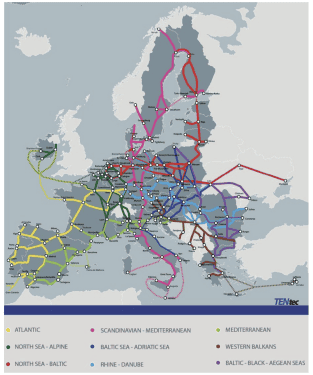The EU’s trans-European transport network policy, (commonly known as the TEN-T policy), is an instrument designed for the development of coherent, efficient, multimodal, and high-quality transport infrastructure across the EU. It comprises railways, inland waterways, short sea shipping routes and roads linking urban nodes, maritime and inland ports, airports, and terminals.
The TENT-T policy is based on Regulation (EU) No 1315/2013, on Union guidelines for the development of the trans-European transport network.
- Timeline
In December 2021, the European Commission put forward a proposal on the revised TEN-T guidelines, to ensure sustainable connectivity through a reliable and high-quality infrastructure network aligned with the objectives of the European Green Deal. In May 2022, the Commission published an amended proposal, extending transport corridors to Ukraine and Moldova and withdrawing plans that included Russia and Belarus.
The Council adopted its General Approach on 5 December 2022. Next to this, the TRAN Committee at the European Parliament adopted its report on the proposal on 13 April 2023.
Last 13 June 2024, the Council adopted the Parliament´s first reading position on the proposal for the revision of the Trans-European Transport Network (TEN-T) Regulation as the legislative measure. The adoption in the Council marks the conclusion of the legislative procedure at first reading. The final text of the Regulation will now be published in the EU Official Journal before entering into force.
- What does it include the new proposal approved last 13 June?
The proposal looks at improving the TEN-T network by making it more reliable, seamless, and more sustainable, in line with the EU Green Deal objectives. Thus, it aims at making transport greener by providing the appropriate infrastructure basis to alleviate congestion and reduce greenhouse gas (GHG) emissions. Please find below a summary of the main issues included in the proposal approved:
- First, an airport shall be considered as part of the comprehensive TEN-T network if it meets at least one of the following conditions (art. 32. 2 of the proposal)
-
- Cargo airports – the total annual cargo volume is at least 0,2% of the total annual cargo volume of all airports of the Union.
-
- Passenger airports – the total annual passenger traffic is at least 0,1% of the total annual passenger volume of all airports of the Union, unless the airport in question is situated outside a radius of 100 km from the nearest airport in the comprehensive network or outside a radius of 200 km where there is a high-speed railway line in the region in which it is situated.
* The total annual passenger volume and the total annual cargo volume are based on the latest available three-year average, based on the statistics published by Eurostat.
- Airports of the core network must be connected with the long-distance rail network, including the high-speed rail network, and road transport infrastructure of the trans-European transport network by 31 December 2030, except where specific geographic or significant physical constraints prevent such connections (Art. 33.1 paragraph a)
- Airports of the comprehensive network with a total annual passenger traffic volume of more than four million passengers must be connected with the long-distance railway network, including with the high-speed rail network, and road transport infrastructure of the trans-European transport network by 31 December 2050, except where specific geographic or significant physical constraints prevent such connections (Art. 33.1 paragraph b)
- Airports may offer at least one terminal which is open to all operators and users in a non-discriminatory way and which shall apply transparent, and non-discriminatory charges (Article 33.1 paragraph c)
- Alternative fuels infrastructure shall be deployed in airports (Article 33.1 paragraph f)
The proposal also aims to Increase the resilience of TEN-T to climate change and other natural hazards or human-made disasters. At the same time, it points to improving the efficiency of the TEN-T governance tools, streamlining the reporting and monitoring instruments and reviewing the TEN-T network design. It also contains provisions revising the Rail Freight Corridor (RFC) Regulation to align it with the revised TEN-T guidelines.
Alignment of the European transport corridors

- Next steps
Since the adoption in the Council marks the conclusion of the legislative procedure at first reading, the final text of the Regulation will now be published in the EU Official Journal and enter into force on the twentieth day following its publication.


